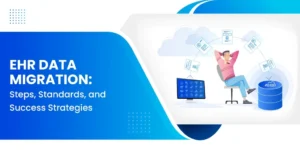In today’s data-driven world, organizations of all sizes struggle with the ever-growing challenge of managing and storing vast amounts of data. Data lakes emerge as a revolutionary solution, offering flexible, scalable, and cost-effective storage, regardless of its format. Whether you’re seeking an efficient way to manage your data ecosystem or exploring options for archiving legacy data, data lakes are worth exploring.
This blog post delves into the definition of data lakes, their advantages, and why they are a compelling option for the archival of legacy data. Data lakes have revolutionized the way organizations store, manage, and secure their data, making them a key player in modern data management.
What is a Data Lake?
A data lake is a central hub that acts as a sponge, soaking up all your data. Unlike traditional data warehouses with rigid structures, data lakes embrace flexibility, allowing you to store raw data without extensive pre-processing. This opens doors to a world of possibilities, from historical analysis to advanced analytics powered by machine learning and artificial intelligence.
The Core Components of Data Lakes
A typical data lake is composed of the following key components:
- Data Ingestion
- Data ingestion is the initial process of building a data lake. It involves collecting, importing, and processing data for immediate use or storage in a database.
- This process handles the intake of data from various sources, including structured, semi-structured, and unstructured data, like databases, weblogs, IoT data, financial transactions, social media data, etc.
- This ensures that all your data is available in one place.
- Data Storage
- Once data has been ingested, the next crucial component is data storage.
- The fundamental characteristic of a data lake storage is its massive scale. Its ability to store petabytes (PB) of data in its raw, untamed format until it’s ready to be consumed grants businesses an outstanding amount of flexibility.
- Data lakes are schema-less; therefore, they are more tolerant to changes in data structure enabling enterprises to scale up or down as required.
- Data Processing and Integration
- This stage involves cleaning, transformation, and aggregation of data before it can be analyzed.
- The ability to process significant volumes of data is what differentiates data lakes from traditional data warehousing solutions.
- Proper data integration ensures the reliability and integrity of data, easing the process of data analytics and the interpretation of actionable insights.
- Data Security and Governance
- This segment is vital as it ensures that the data lakes are safe, secure, and compliant with set laws and regulations.
- Data lakes must have proper security measures in place, including role-based access control (RBAC), encryption, and auditing capabilities.
- Sound data governance practices like quality control, metadata management, and data lineage are also important to ensure the proper use of data within the organization.
- Metadata is crucial for understanding and cataloging the data within the lake. It provides context and helps users discover and access the data they need.
Why are Data Lakes a Good Option for Archiving Legacy Data
The rapid evolution of technology and the increasing volume of data organizations produce and handle cause older data, or what’s known as legacy data, to pile up. Harnessing and understanding this data could unlock valuable insights. Hence, safekeeping and managing this extensive load of unstructured data is essential. One of the most efficient ways to do this is by archiving them in data lakes.
Data lakes offer several advantages that make them a compelling option for archival purposes.
Advantages of Archiving and Storing Data in Data Lakes
- Cost-Effectiveness: Storing data in a data lake is often more cost-effective than traditional archiving methods. Cloud-based data lakes offer scalable storage at a lower cost.
- Accessibility: Legacy data archived in a data lake remains easily accessible. Users can retrieve and analyze archived data as needed, without complex retrieval processes.
- Scalability for Future Growth: Data lakes can accommodate ever-growing volumes of historical data, ensuring that archived data is not a burden on storage resources. Data lakes can be scaled horizontally to accommodate large data volumes, ensuring that your organization’s data growth is not hindered.
- Flexibility: Data lakes can store data in its raw form, making it flexible and adaptable to various data types and structures.
- Data Integration: Data lakes integrate data from diverse sources, providing an opportunity for effective data management and integration across different organizational departments and enabling a unified view of all your data for analysis.
- Data Governance: With proper metadata management, data lakes support better data governance and compliance with data regulations.
- Data Analytics and Insights: Archived data can be analyzed alongside current data, providing valuable insights for business intelligence and historical trend analysis. Data lakes provide a foundation for advanced analytics, machine learning, and artificial intelligence applications, driving data-driven decision-making.
In a nutshell, the conversion to data lakes offers more effective data management solutions, especially with legacy data, allowing organizations to harness this untapped resource for business growth.
Data Lake as an Archive Warehouse
A well-managed data lake serves as an expansive repository for storage, processing, analysis, and visualization of data in various formats.
Business Data Needs an Archive Warehouse
Business data is a valuable resource that, in essence, requires a comprehensive, secure, and efficient storage system. This data may be in different formats (structured, semi-structured, or unstructured); be from various sources (internal applications, IoT devices, or external interfaces); and be intended for various uses (reporting, analytics, or forecasting). It is also essential that this warehouse is designed and constructed in a way that makes both retrieval and analysis of data straightforward and user-friendly. This is where data lakes come into play, serving as an ultra-modern archive warehouse.
How Data Lakes Can Improve Your Security Posture
Data security is a paramount concern for organizations, and data lakes can play a vital role in improving your security posture.
Security Benefits of Data Lakes
- Data Encryption: Data lakes typically provide encryption features, ensuring that data at rest and in transit is secure.
- Access Control: Role-based access control and fine-grained permissions enable organizations to restrict data access to authorized users only.
- Auditing and Monitoring: Data lakes often include robust auditing and monitoring tools to track data access and changes.
- Data Masking: Sensitive data can be masked or redacted within data lakes to protect confidential information.
Best Practices for Data Lake Implementation
Deploying a data lake can be a complex undertaking, and companies may stumble if they proceed without a clear vision, strategic planning, and proper execution. Here are some recommended best practices to ensure successful data lake implementation.
Define Clear Data Goals and Objectives
Establishing clear data goals and objectives is crucial. Companies need to understand what type of data they are managing and what they aim to achieve with it. Whether the goal is to improve customer experience, make real-time decisions, predict future trends or anything in between, having well-defined objectives facilitates the design and configuration of the data lake. What are the exact steps that should be taken?
- Identify the key business problems you want to solve.
- Determine the type of data needed to address these problems.
- Decide the analytics to be performed on the data.
Develop a Data Governance Strategy
A robust data governance strategy is instrumental in maintaining data quality, security, and privacy. It should outline who has access to the data, how it is used, and how data quality is maintained. This can be done through the following steps:
- Create data stewardship roles.
- Implement data access policies.
- Standardize data definitions and metadata.
Implement a Scalable and Flexible Data Architecture
The flexibility and scalability of a data lake are its distinguishing features. By implementing a scalable and flexible data architecture, you can handle massive amounts of structured, semi-structured, and unstructured data. Do this by deciding to:
- Use scalable storage systems.
- Employ flexible data models, which can evolve with changing business needs.
- Leverage big data technologies.
Engage Cross-Functional Teams for Collaboration and Buy-In
Building a data lake is not a one-department job. Engage cross-functional teams including data scientists, IT specialists, and business analysts for their unique perspectives. Their collaboration ensures that the data lake serves the needs of the entire organization. Ensure everyone is working together appropriately and:
- Involve all stakeholders from the start.
- Facilitate consistent communication and collaboration.
- Encourage ownership of data lake success across the organization.
Conclusion
Data lakes are a transformative solution for modern data management, offering scalability, flexibility, and advanced analytics capabilities. Archiving legacy data in a data lake can streamline data preservation while improving accessibility. Understanding the differences between data lakes and data archives is crucial for selecting the right approach for your organization.
Moreover, data lakes can significantly enhance your security posture, ensuring that your valuable data remains safe and protected. Embrace the power of data lakes and unlock the full potential of your data resources.
For organizations seeking flexibility and scalability in their data management, data archival solutions at Platform 3 Solutions offer a comprehensive approach. With raw data storage and seamless integration, our solutions enhance your data management capabilities.
Don’t wait; Talk to us today and empower your organization to make the most of your data resources, ensuring efficient data preservation and security. Embrace the power of data lakes and unlock the full potential of your data resources with Our expertise and tools.

Board of Director, Chief Architect/Product Owner
Passionate about automating and solving complex problems with data for Fortune 500 clients. He has developed leading edge technology solutions to address the archival, decommissioning and migrating of legacy systems. Under his leadership, he has developed the Archon line of products and solutions to help clients in their open-source and digital transformation journeys.



